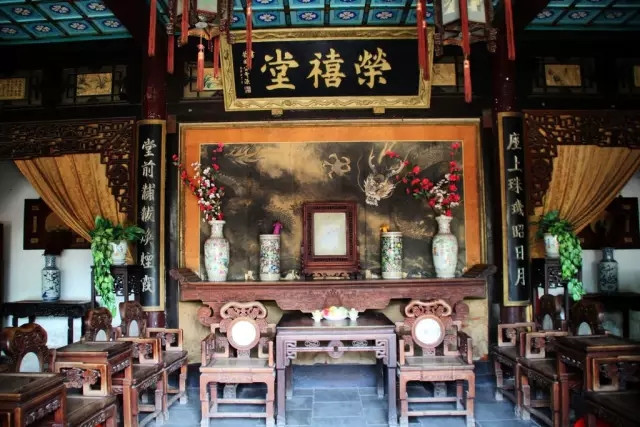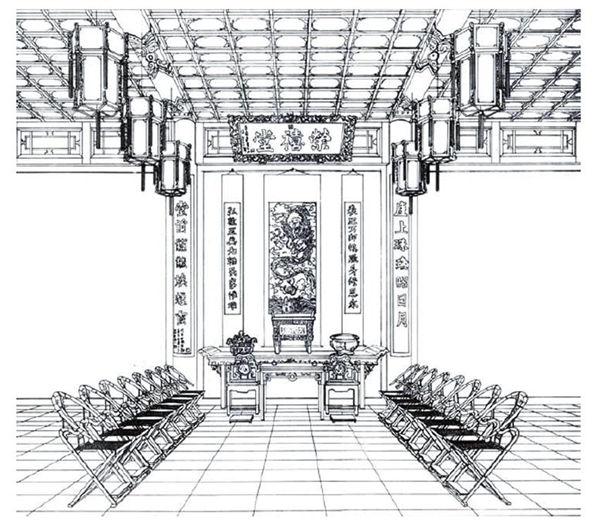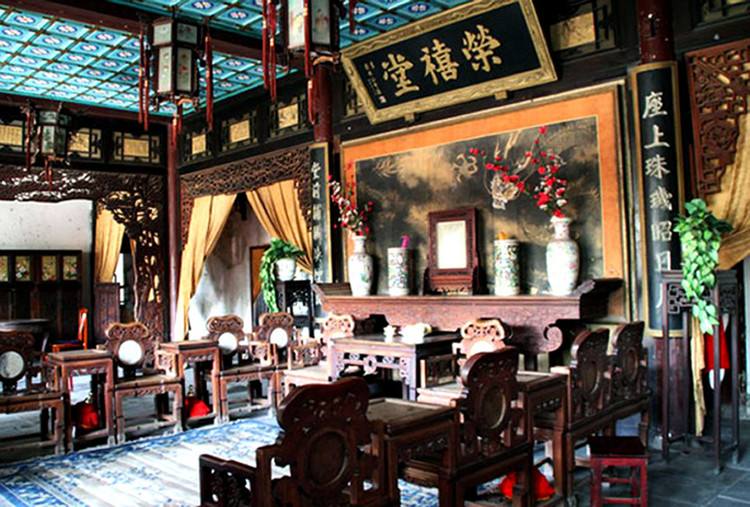《红楼梦》英译品读 (五)
作者:王晓辉
《红楼梦》不仅是一部伟大的文学作品,也是一部中国明清时代社会生活的百科全书。诗词歌赋,酒令灯谜,花鸟鱼虫,星象中医,涵盖了当时社会生活的方方面面。清代学者王希廉谓其“包罗万象,囊括无遗,可谓才大如海,岂是别部小说所能望其项背。”
撇开错综复杂的故事情节不说,仅书中涉及的楼阁厅堂楹联匾额器物摆设就够开一门民俗课了。

《红楼梦》第三回, 林黛玉到荣国府见王夫人。内堂的陈设是这样的:
“进入堂屋中,抬头迎面看见一个赤金九龙青地大匾,匾上写着斗大的三个大字,是“荣禧堂”,后有一行小字:“某年月日,书赐荣国公贾源”,又有“万几宸翰之宝”。大紫檀雕螭案上,设着三尺来高青绿古铜鼎,悬着待漏随朝墨龙大画,一边是金蜼彝,一边是玻璃𥁐,地下两溜十六张楠木交椅,又有一副对联,乃乌木联牌,镶着錾银的字迹,道是:
“座上珠玑昭日月,堂前黼黻焕烟霞。”
曹雪芹通过对堂屋陈设摆件的描写,展示了荣国府的奢华与尊贵。这些陈设摆件,极具中国特色,有些甚至是中国独有的东西。译者如果要向外国读者解释清楚,同时还要保持语言的流畅优美,实在是太不容易了。
原文第一句,霍克斯的译文是:
High overhead on the wall facing her as she entered the hall was a great blue board framed in gilded dragons, on which was written in large gold characters
THE HALL OF EXALTED FELICITY
with a column of smaller characters at the side giving a date and the words '...written for Our beloved Subject, Jia Yuan, Duke of Rong-guo', followed by the Emperor's private seal, a device containing the words 'kingly cares' and 'royal brush' in archaic seal-script.
杨宪益先生的译文:
Once inside the hall she looked up and her eye was caught by a great blue tablet with nine gold dragons on it, on which was written in characters large as peck measures:
Hall of Glorious Felicity
Smaller characters at the end recorded the date on which the Emperor had conferred this tablet upon Chia Yuan, the Duke of Jungkuo, and it bore the imperial seal.
译文流畅准确,这一点毋庸置疑,只是在翻译的方法上,霍克斯和杨宪益各有侧重。杨宪益语言精练,叙述清楚,而霍克斯则更多地站在外国读者的角度,力求把每一个细节都解释得明明白白。

“赤金九龙青地大匾”,霍克斯的译文是‘a great blue board framed in gilded dragons’,一个青色的大匾额,上面描有金龙,环绕在匾额的四周;杨宪益的译文是‘a great blue tablet with nine gold dragons on it’,一只青色大匾,上面有九条龙。原文中曹雪芹并没有说明那九条描金的龙究竟在匾上什么位置,但霍克斯根据自己对匾额的理解,清楚地告诉读者那些描金的龙是在匾额的框子上的(framed in gilded dragons),让没有亲眼见过匾额的英语读者脑海中有了清晰的形象。
匾额上“荣禧堂”三字,霍杨二人的翻译大同小异,Glorious与Exalted意思虽有细微差别,但无关宏旨。值得注意的是“荣禧堂”后面的一行小字:“某年月日,书赐荣国公贾源”,又有“万几宸翰之宝”。杨宪益先生言简意赅,用叙述语言说明后面一行小字记录了皇帝赐匾的时间并鈐有一枚玉皇帝的印章。霍克斯则不厌其烦,不仅将匾额上小字的内容逐字译出,还加入了自己的解释。最有意思的是霍克斯将“书赐荣国公贾源”译成了‘written for Our beloved Subject, Jia Yuan, Duke of Rong-guo’,再倒译回中文就成了“写给我们亲爱的的大臣荣国公贾源”。这很明显是西方君主的题赠习惯,也非常易于英语读者的理解,但这样翻译就成了朋友之间的笔墨往来,把皇帝和大臣放在平等的位置上了。汉语中也有“爱卿”一词,是皇帝对臣子的爱称,翻译过来还就是my beloved subject,但这种称呼多见于小说特别是戏曲,现实生活中很少见。
对匾额上那枚印章的翻译,霍克斯也是煞费苦心。中国古代对于印章非常讲究,皇帝用“玺”,大臣用“印”,老百姓用的叫“戳儿”,从字面上看尊贵和正式程度上就有天壤之别,普通百姓用印也就是随便“戳”一下子,留个印记而已。一般皇帝在题字、藏书时用的印章与册封、颁诏时用的玉玺是不一样的,属于“闲章”,如乾隆皇帝的“古稀天子之宝”和“十全老人之宝”,书中提到的这枚“万几宸翰之宝”也是一枚闲章。霍克斯没有用‘imperial seal’,而是翻译成了‘the Emperor's private seal’,显然是做足了功课。不仅如此,他还将印章上的“万几”和“宸翰”也完整译出。“万几”就是“日理万机”的“万机”,表示皇帝很忙,“宸翰”则是“御笔”的意思,所以,霍克斯最后将这枚印章描述为‘... followed by the Emperor's private seal, a device containing the words 'kingly cares' and 'royal brush' in archaic seal-script’,可谓细致入微。不过,加上了‘kingly care’和‘royal brush’也有可能给英语读者带来新的困惑。从这些细节也可以看出来,霍、杨两位大师在翻译理念上还是有差异的。
原文的第二句主要是描写厅堂中的器物摆设和一副对联,霍克斯是这样翻译的:
A long, high table of carved red sandalwood, ornamented with dragons, stood against the wall underneath. In the center of this was a huge antique bronze ding, fully a yard high, covered with green patina. On the wall above the ding hung a long vertical scroll with an ink-painting of a dragon emerging from clouds and waves, of the kind often presented to high officials in token of their office. The ding was flanked on one side by a smaller antique bronze vessel with a pattern of gold inlay and on the other by a crystal bowl. At each side of the table stood a row of eight yellow cedar-wood armchairs with their backs to the wall; and above the chairs hung, one on each side, a pair of vertical ebony boards inlaid with a couplet in characters of gold:
(on the right-hand one)
May the jewel of learning shine in the house more effulgently than the sun and moon.
(on the left-hand one)
May the insignia of honor glitter in these halls more brilliantly than the starry sky.
杨宪益先生的译文相对简洁,字数只有霍克斯译文的一半左右。对于紫檀雕螭案、青绿古铜鼎、金蜼彝、玻璃𥁐、楠木交椅等物件的名称,霍克斯与杨宪益的翻译非常相近,所不同的是霍克斯按照中国传统厅堂的设置,还原了每一样家具和摆设的位置以及相互的空间关系。以“大紫檀雕螭案”为例,霍克斯在‘a table of carved red sandalwood ornamented with dragons’之外,还加上了‘stood against the wall underneath’,告诉读者“匾额下靠墙立着一个紫檀雕螭大条案”。另外,在翻译“待漏随朝墨龙大画”时,霍克斯没有简单地说‘there hung a big picture of ink-painting dragon in the sea (or waves),而是告诉读者,‘On the wall above the ding hung a long vertical scroll with an ink-painting of a dragon emerging from clouds and waves, of the kind often presented to high officials in token of their office’(在鼎的上方墙上,挂着一幅竖轴大画,画中一条墨龙在云海中飞腾,此类题材的画作,往往是献给达官贵人的,以彰显其地位之荣耀)。霍克斯一定是下功夫研究了中国古典厅堂陈设的规矩,知道什么是“条案”,什么是“中堂画”,所以,他才将“大紫檀雕螭案”翻译成 ‘a long, high table of carved red sandalwood, ornamented with dragons’,将“待漏随朝墨龙大画”翻译成‘long vertical scroll’。

这段文字的最后是一副对联:
座上珠玑昭日月,堂前黼黻焕烟霞。
这是一副非常典型的中堂对联,悬挂在正厅,与中间的“待漏随朝墨龙大画”相呼应,彰显了贾府的荣耀地位。
霍克斯的翻译:
(on the right-hand one)
May the jewel of learning shine in the house more effulgently than the sun and moon.
(on the left-hand one)
May the insignia of honor glitter in these halls more brilliantly than the starry sky.
杨宪益的翻译:
Pearls on the dais outshine the sun and moon;
Insignia of honor in the hall blaze like iridescent clouds.
英语是字母文字,不能像汉语一样,上下联在结构和长短上一一对应,但可以看出两位译者已经尽了最大努力,使上下联相对整齐。从翻译效果上看,杨译简洁工整,意象鲜明;霍译深入细致,滴水不漏。
珠玑是指珠宝,黼黻则是官服上的纹饰,这两句话形容在此居住和往来的人物衣着华贵,光彩照人。霍克斯不仅将对联的内容准确译出,还捕捉到了对联文字背后的隐喻。“珠玑”二字,字面上是指珠宝,但更多的是用来比喻优美的辞章和文字,如“字字珠玑”“满腹珠玑”“口吐珠玑”,所以,这副对联说的是贾府诗书传家,文彩俊逸,而且世代簪缨,富贵尊荣。霍克斯将“座上珠玑”翻译成‘the jewel of learning in the house’, 意思是座上宾客,文彩风流,谈吐不俗,点出了“珠玑”的深一层含义。
读《红楼梦》英译本最大的收获,就是进一步感受到原著的博大精深,从而更加体会到译者的艰辛。霍克斯为了专心翻译《红楼梦》,毅然辞去牛津大学教授的职位;杨宪益、戴乃迭夫妇,历经政治冲击和生活的磨难,仍在古稀之年,笔耕不辍。翻译大师呕心沥血之作,拓展了《红楼梦》的生命空间,也最完整的诠释了“译者”二字的真正内涵。
 0
0 







Go to Forum >>0 Comment(s)